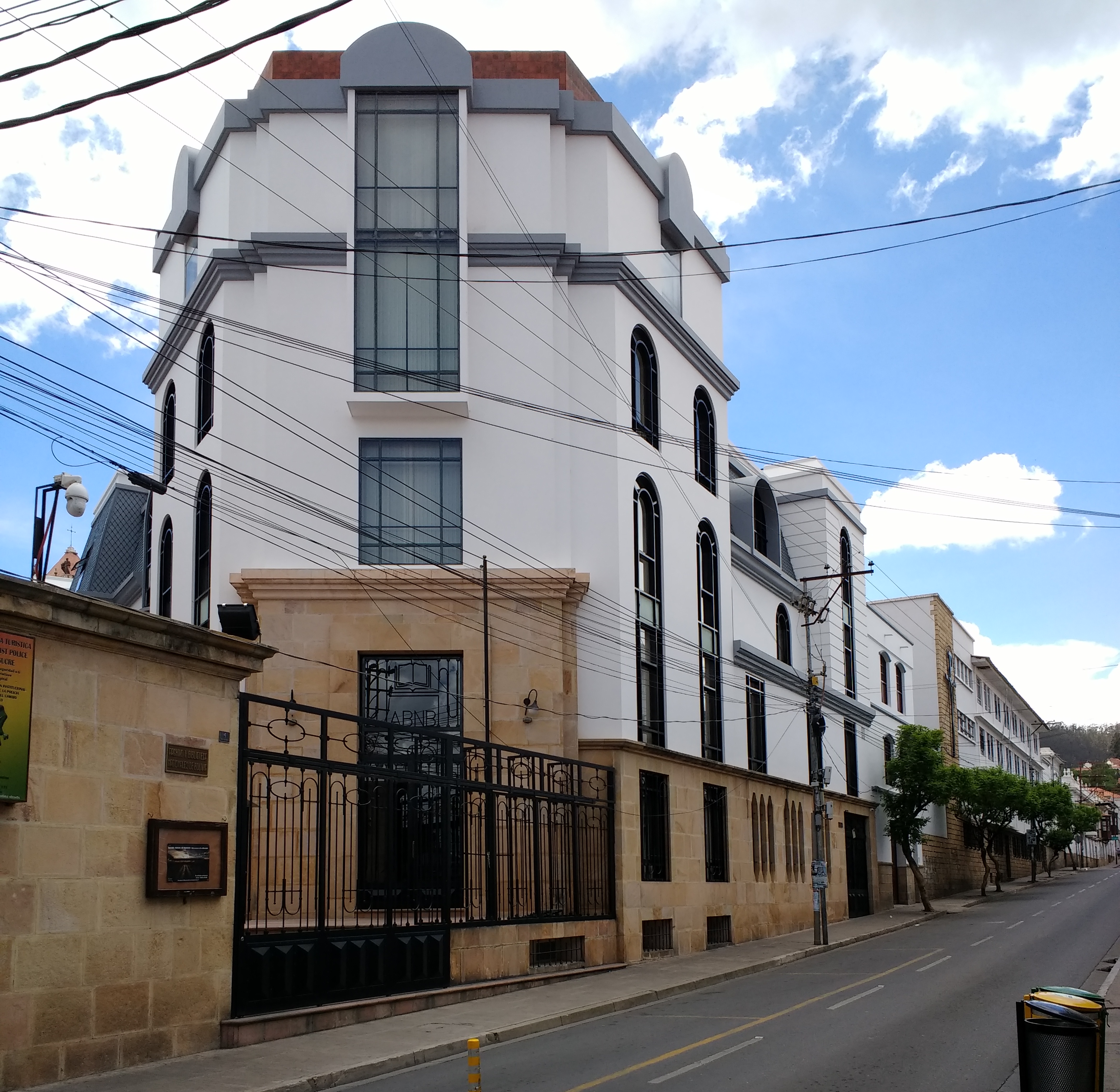|
National Archive And Library Of Bolivia
The National Archive and Library of Bolivia () are located in Sucre. () The institution was established in 1836. Its collections has 114,000 volumes. See also * List of national archives * List of national librariesReferences External links * http://www.nationallibraryofbolivia.orgBolivia
, image_flag = Bandera de Bolivia (Estado).svg
, fla ...
[...More Info...] [...Related Items...] OR: [Wikipedia] [Google] [Baidu] |
Sucre
Sucre () is the Capital city, capital of Bolivia, the capital of the Chuquisaca Department and the List of cities in Bolivia, 6th most populated city in Bolivia. Located in the south-central part of the country, Sucre lies at an elevation of . This relatively high altitude gives the city a subtropical highland climate with cool temperatures year-round. Its pre-Columbian name was Chuquisaca; during the Spanish Empire it was called La Plata. Before the arrival of the Spanish, the city of Chuquisaca had its own autonomy with respect to the Inca Empire (the Charca people, Charcas were the only people that did not pay the ransom for the Inca captive). Today, the region is of predominantly Quechua people, Quechua background, with some Aymara people, Aymara communities and influences. Today Sucre remains a city of major national importance and is an educational and government center, being the location of the Bolivian Supreme Court. Its pleasant climate and low crime rates have made th ... [...More Info...] [...Related Items...] OR: [Wikipedia] [Google] [Baidu] |
List Of National Archives
National archives are central archives maintained by countries. This article contains a list of national archives. Among its more important tasks are to ensure the accessibility and preservation of the information produced by governments, both analogically and digitally, for the government itself, researchers and generations to come. Some national archives collections are large, holding millions of items spanning several centuries, while others created recently have modest collections. In the last decade, digitization projects have made possible to browse records and contents online, although no archive have their entire collections published on the web. A B C D * Danish National Archives * Archivo General de la Nación de República Dominicana E * National Archives of Ecuador * Egyptian National Library and Archives * National Archives of Estonia * Eswatini National Archives * National Archives and Library of Ethiopia F * Jane Cameron National Archives (Falkla ... [...More Info...] [...Related Items...] OR: [Wikipedia] [Google] [Baidu] |
List Of National Libraries
A national library is established by the government of a nation to serve as the pre-eminent repository of information for that country. Unlike public libraries, they rarely allow citizens to borrow books. Often, they include numerous rare, valuable, or significant works; such as the Gutenberg Bible. National libraries are usually notable for their size, compared to that of other libraries in the same country. Some national libraries may be thematic or specialized in some specific domains, beside or in replacement of the 'main' national library. Some national entities which are not independent but who wish to preserve their particular culture, have established a national library with all the attributes of such institutions, such as legal deposit. Many national libraries cooperate within the National Libraries Section of the International Federation of Library Associations and Institutions (IFLA) to discuss their common tasks, define and promote common standards and carry out proje ... [...More Info...] [...Related Items...] OR: [Wikipedia] [Google] [Baidu] |
National Library
A national library is a library established by a government as a country's preeminent repository of information. Unlike public library, public libraries, these rarely allow citizens to borrow books. Often, they include numerous rare, valuable, or significant works. A national library is that library which has the duty of collecting and preserving the literature of the nation within and outside the country. Thus, national libraries are those libraries whose community is the nation at large. Examples include the British Library, and the Bibliothèque nationale de France in Paris.Line, Maurice B.; Line, J. (2011). "Concluding notes". ''National libraries'', Aslib, pp. 317–318Lor, P. J.; Sonnekus, E. A. S. (2010)"Guidelines for Legislation for National Library Services", International Federation of Library Associations and Institutions, IFLA. Retrieved on 10 January 2010. There are wider definitions of a national library, putting less emphasis to the repository character. National ... [...More Info...] [...Related Items...] OR: [Wikipedia] [Google] [Baidu] |
South America
South America is a continent entirely in the Western Hemisphere and mostly in the Southern Hemisphere, with a relatively small portion in the Northern Hemisphere at the northern tip of the continent. It can also be described as the southern subregion of a single continent called America. South America is bordered on the west by the Pacific Ocean and on the north and east by the Atlantic Ocean; North America and the Caribbean Sea lie to the northwest. The continent generally includes twelve sovereign states: Argentina, Bolivia, Brazil, Chile, Colombia, Ecuador, Guyana, Paraguay, Peru, Suriname, Uruguay, and Venezuela; two dependent territories: the Falkland Islands and South Georgia and the South Sandwich Islands; and one internal territory: French Guiana. In addition, the ABC islands of the Kingdom of the Netherlands, Ascension Island (dependency of Saint Helena, Ascension and Tristan da Cunha, a British Overseas Territory), Bouvet Island ( dependency of Norway), Pa ... [...More Info...] [...Related Items...] OR: [Wikipedia] [Google] [Baidu] |
Culture Of Bolivia
Bolivia is a country in South America, bordered by Brazil to the north and east, Paraguay and Argentina to the south, Chile to the west, and Peru to the west. The cultural development of what is now Bolivia is divided into three distinct periods: pre-Columbian, colonial, and republican. Important archaeological ruins, gold and silver ornaments, stone monuments, ceramics, and weavings remain from several important pre-Columbian cultures. Major ruins include Tiwanaku, Samaipata, Inkallaqta and Iskanwaya. The country abounds in other sites that are difficult to reach and hardly explored by archaeologists. The Spanish brought their own tradition of religious art which, in the hands of local indigenous and ''mestizo'' builders and artisans, developed into a rich and distinctive style of architecture, literature, and sculpture known as "Mestizo Baroque." The colonial period produced not only the paintings of Perez de Holguin, Flores, Bitti, and others, but also the works of skilled bu ... [...More Info...] [...Related Items...] OR: [Wikipedia] [Google] [Baidu] |
Libraries In Bolivia
A library is a collection of materials, books or media that are accessible for use and not just for display purposes. A library provides physical (hard copies) or digital access (soft copies) materials, and may be a physical location or a virtual space, or both. A library's collection can include printed materials and other physical resources in many formats such as DVD, CD and cassette as well as access to information, music or other content held on bibliographic databases. A library, which may vary widely in size, may be organized for use and maintained by a public body such as a government; an institution such as a school or museum; a corporation; or a private individual. In addition to providing materials, libraries also provide the services of librarians who are trained and experts at finding, selecting, circulating and organizing information and at interpreting information needs, navigating and analyzing very large amounts of information with a variety of resources ... [...More Info...] [...Related Items...] OR: [Wikipedia] [Google] [Baidu] |
Archives In Bolivia
An archive is an accumulation of historical records or materials – in any medium – or the physical facility in which they are located. Archives contain primary source documents that have accumulated over the course of an individual or organization's lifetime, and are kept to show the function of that person or organization. Professional archivists and historians generally understand archives to be records that have been naturally and necessarily generated as a product of regular legal, commercial, administrative, or social activities. They have been metaphorically defined as "the secretions of an organism", and are distinguished from documents that have been consciously written or created to communicate a particular message to posterity. In general, archives consist of records that have been selected for permanent or long-term preservation on grounds of their enduring cultural, historical, or evidentiary value. Archival records are normally unpublished and almost al ... [...More Info...] [...Related Items...] OR: [Wikipedia] [Google] [Baidu] |

.jpg)






